A Framing Statement
Our Site Specific performance, named Recollection, is a series of one to one performances in a unique location in the Lincoln Drill Hall. The piece was based on the stories of lost and found objects. Through the use of storytelling and sensory-based experiences, we immersed the audience in the forgotten history of the Lincoln Drill Hall. This was performed on Wednesday 4th May 2016. The performance consisted of 10 to 15-minute slots between the times of 12 pm and 3:30 pm. Our performance was inspired by various Site Specific practitioners such as those from the One-To-One Performance – A Case Study Guide such as Michael Pinchbeck and a company called Curious.
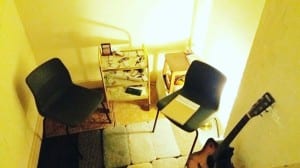
Influences
One-To-One Performance – A Case Study Guide
“One to One” or “One on One” or “Audience of One” are all terms used to describe a performance that invites one audience member to experience the piece on their own. Such performance interactions last for around five or ten minutes” (Zerihan, 2009, 3). The idea of having a one-to-one performance is that two people discuss a matter directly, without anybody else, usually one feeding information to the other.
The Long and Winding Road (2004)
The performance that influenced our piece was The Long and Winding Road (2004) created by Michael Pinchbeck. The performance “is a journey that perhaps in one way or another we have all taken or seen a close friend take. It is about the experience of loss, memory, mourning and recovery.” (Zerihan, 2009, 63). The performance mainly inspired us not just to create stories, but it gave us an idea concerning interaction with the audience member. “Hi, welcome aboard… Would you like a travel sweet, you don’t have to” (Pinchbeck, 2004). Pinchbeck made sure the audience member or passenger felt relaxed before he began his journey inside the car. Drawing on this, we used a poster from the 7th August 1915, the text of which was: “Macintosh’s Toffee De Luxe to the Troops and the great sailors. It gives them great pleasure, it helps them to forget danger, it passes away many a tedious hour, it sustains their stamina” (The Lincolnshire Chronicle, 1915).
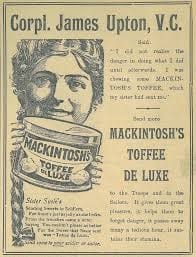
http://file:///C:/Users/Adam/Downloads/Corporal-James-Upton-VC%20(1).pdf
The poster inspired us to build on our original idea where we based our Site Specific performance on the two soldiers, Leonard Keyworth, and James Upton. They inspired us to make the audience member feel tranquil and feel more in the comfort zone before we take him or her on a journey through the history of the objects.
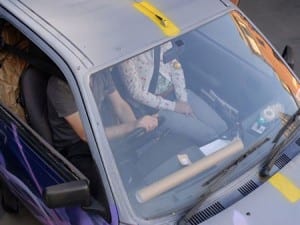
https://www.google.co.uk/search?q=A+Long+Winding+Road+Michael+Pinchbeck&biw=1242&bih=606&source=lnms&tbm=isch&sa=X&ved=0ahUKEwjh2JvI29XMAhWHBsAKHRczCb8Q_AUIBygC#imgrc=9a1SXtXN40CQfM%3A
Between Pinchbeck and the audience member, they felt that “the mirror doubled the distance between us. I hope it enabled the experience to feel intimate but detached, close but not too uncomfortable.” (Zerihan, 2009, 63). Being in a one-to-one performance can sometimes be uncomfortable for the audience member, depending on how distant the performer is from them. With our performance, we had a series of objects on a table, and we doubled the distance between the audience member and myself.
To make the audience member feel more relaxed and not too uncomfortable, Pinchbeck had casual radio music on in his car. This idea inspired us to have audio in our performance. If the audience member wanted, they could have the music played while discussing the objects. The type of music we decided to play were songs sung by artists and bands such as The Rolling Stones and The Stranglers who performed at the Drill Hall in the 1960’s before they became famous. We only played these pieces of music if the audience member picked objects which related to the music, such as the guitar pics and the music stand. Constantly throughout the performance we played “Divenire”, “I Giorni” and “Primavera” by Ludovico Einaudi, which were able to relax the audience member even more to avoid any awkwardness.
Curious – Lost and Found
Regarding coming up with an idea that is relevant to the objects we chose, we were influenced by a theatre company called Curious. They created a piece called Lost and Found. “What is lost and what is found in places undergoing rapid regeneration and change?” (Lost and Found, 2005). Their performances include personal journeys which lead them to have conversations with audience members by asking them rhetorical questions, about whether they can relate to that journey or not.
An Analysis Of Process
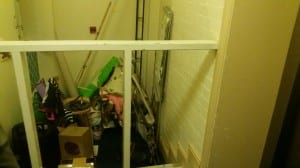
(Adam Cockerill, 2016)
On the first day of having our Site Specific lesson at the Lincoln Drill Hall, we were shown around by Chris Kirkwood, the Chief Executive. He gave us some history of the building. We came to the backstage stock cupboard and we found out that nobody had performed in this room in the past. This created an unusual space which we thought the audience would enjoy.
The original idea for our piece, which we had titled Heroism was an immersion based performance designed to remove the audience members from the balcony room and transport them to a trench in the First World War. This idea came about from the two memorial stones laid on the forecourt of the Drill Hall and we wanted to recreate a believable and intense scenario based around the exploits of these heroes.
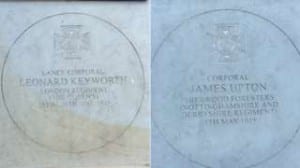
(Adam Cockerill, 2016)
Further research at The Archives led us to find out about a toffee endorsement by one of the soldiers which we wanted to include in our performance as it is a unique and interesting link to the site itself. When the audience experienced our performance, we wanted them to feel how soldiers felt during World War I. We wanted to make the audience feel as if they were in a battle and to pay tribute to them and make them show more respect for the soldiers who fought for us. We did this by placing an audience member in a chair and putting a soldier’s helmet on their head and a blanket over their shoulders. We then turned the lights off to make the room dark. We made the two soldiers come to life by portraying them.
However, this idea spawned debate within the group. We all have a relationship with theatre and the stage, as actors. Our personalities alter into different characters; we take on a new procedure of expression and voice completely different to that of our everyday lives. As drama students, we are used to devising for theatrical performances; we thought that this idea was too theatrical with the use of characters because we were portraying the two soldiers which we thought took attention away from the Site Specific element and was more focused towards our performance abilities.
We decided to pursue an idea where the three of us lead one-to-one performances with audience members based on telling the stories of lost and found objects from what we found in the backstage cupboard, abandoned and forgotten. An idea that developed from this was the potential use of the toffee as one of the items related to the Drill Hall, and that our research into the soldiers would not be lost as a result of this drastic change in style of performance. Expanding on that idea, was a suggestion from Michael Pinchbeck that music could be a part of the performance and a lost instrument could be used to play one of the songs that were played at the Drill Hall during the venue’s time as a music-based venue. An idea that stemmed from this led to us researching more about the Drill Hall. We found out that famous bands such as The Rolling Stones performed at the venue on the 31st December 1963 (before they became famous). Our piece was moving more towards being a more intimate and personal performance, designed to use the natural surroundings of the room to give our piece a surreal atmosphere.
“Story-telling is indicative of a recent development in socially engaged site-specific art” (Till, 2008, 102). Using objects, we are engaging the audience by telling stories and or narratives, which stimulates one’s social memory. For example, the audience will engage emotionally by relating it to their lives and experiences. “Performers devise methods of working with the audience very close to them indeed” (Pearson, 2010, 174). We will do this by patiently asking questions to the audience member if the specific item or items mean anything to them or to somebody else they know.
In order to tell stories about objects, we had to search for ones that interested us and which reminded us of the history of the Drill Hall, whether it was fictional or non-fictional. Jaimie brought in some antique objects that belonged to his grandfather. Jake brought in objects such as a piece of rope which we told the story of Rosamund Ackwarth, which is one of the long-standing and the most significant non-fictional stories of the Drill Hall. We decided to have 24 objects altogether. The reason for this is so the audience member had a wide choice of objects to choose from.
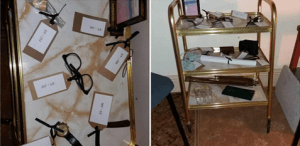
(Adam Cockerill, 2016)
Once we had written our stories about the objects, we wanted to try it out with an audience member. I wanted to play the first curator who escorted the audience member up in the lift and Jake wanted to play the second curator who tells the stories. After the run, we felt that the audience member looked rather uncomfortable in the lift and in the room. How we solved this problem was that an idea came to us and we thought we would bring back the toffee endorsement as it calms peoples nerves and we told them a story in the lift about why we gave them a toffee and the audience member felt more relaxed.
Another difficulty we faced during the rehearsal process was our approach towards the audience member. Michael felt that we were being too informative. We took influence from how the way Michael approached us, as he was very calm and he made us feel more relaxed.
A Performance Evaluation
Since doing the Site Specific Performance module, it has made me realise that you can perform anywhere, from performing in a theatre to performing in a town centre, a library, a museum and a stock cupboard.
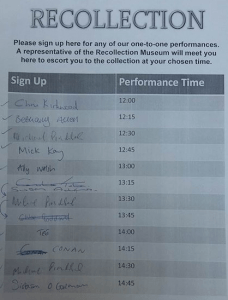
(Adam Cockerill, 2016)
The audience signed up for a 10-minute slot in the site-specific box office that had been set up for sign-up sheets. The performance took place starting from the backstage lift on the ground floor where an audience member was greeted by either Jaimie, Jake or myself, as curators, and one of us escorted that member to the backstage cupboard. In the lift, we offered a toffee to the audience member to calm their nerves before they enter the Recollection Museum. Then they were greeted by another curator who sat the audience member down. We asked them to pick up an object from the Recollection table, and we intrigued the audience by telling a story about that object, relating to the Drill Hall, whether it is fictional or non-fictional. After 10 minutes, the curator took a picture of the audience member, holding their favourite object. The picture was then placed into the memories section of the Recollection book. Then the audience member was escorted down the lift by the first curator. They were then asked what their favourite object was and how that object had any relation to them.
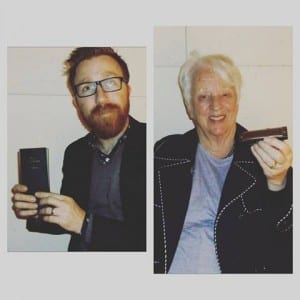
(Jake Skelton, 2016)
During the 3 hours, we had a total of 14 audience members. I was initially worried we would not have enough people, but I felt that this was a great success.
I felt one of my strengths during this performance was that eventually my confidence grew and that furthered my communication skills towards the audience members. “One to One performances feel personal, and if we commit ourselves to them, they can affect us in a myriad of ways.” (Zerihan, 2009, 3-4). I felt we made it achievable to make it feel personal for each audience member, as each person will have felt differently about the objects they picked. One audience member remained reminiscent about the mouth organ as it reminded her of her father playing it when he fought in World War II and I told a similar story regarding that item. One audience member remained enlightened and another was intrigued to know more about the items. However, my weakness was that I was very nervous with the first audience member, as it was my first time performing in a one-to-one performance and that had a massive impact on my confidence. How I could have overcome this is during the rehearsal process, when I could have practiced more with my peers during class time and that way I could have been engaged more and be confident.
The difficulties that Jaimie, Jake and myself faced was something as simple as walking in a lift and pressing a button. We did have issues with the lift as it took quite some time for the lift to respond to us pressing the button to go up and at first. With saying this, it was hard to relax the audience member as one looked quite anxious until I offered her a toffee. Considering the lift took its time to go up, it was hard for me to carry on the conversation with the first audience member I took up.
One of our strengths as a group were what we were wearing for the performance. I felt that we dressed appropriately and we were represented as curators, which was our intention, as we immersed the audience in the forgotten stories of the Drill Hall. As a group, we went to places such as The Archives, The Art Gallery and The Collection and we took into account what they were wearing. I wore a white shirt, a black tie, black trousers and black shoes.

One of our weaknesses was timing because I felt that we were going over the limit at the beginning. As performers, we were too focused on our performance and we lost track of time, only by a few minutes, but this had a massive impact on the other audience members’ appointment time as they had to wait a little longer. Therefore, during the next few runs, we decided as a group that the first curator entered the Recollection room from the kitchen area, which was the second curator’s cue to finish his story, so we did not lose track of time.
As an individual, the one thing I would change if I performed again is be less nervous and to try and avoid hesitation. How I would overcome this is to be even more familiar with what story I want to tell regarding the objects. Furthermore, I would try and lengthen the stories a bit more for the reason that I felt the stories I was telling were a bit too short.
Overall, I thought the performance went very well and we received great feedback from the audience members. A couple of the Drill Hall staff members came to watch us and they told us how they found it very intriguing as they learnt some new information about the entertainment venue.
I am positive that we managed to achieve our aim to commemorate the lost and found items as we shared the stories of what happened before they were abandoned with new people, and helped people reminisce.
Word Count: 2,529
Bibliography
Curious, (2005). ::: curious ::: project ::: lost & found :::. [online] Placelessness.com. Available at: http://placelessness.com/project/1003/lost–found/ [Accessed 15 Apr. 2016].
Pearson, M. (2010). Site-specific performance. Houndmills, Basingstoke, Hampshire: Palgrave Macmillan.
Pinchbeck, M. (2004). The Long and Winding Road – One-to-one performance. [online] YouTube. Available at: https://www.youtube.com/watch?v=yz6hpT-4CxE [Accessed 15 Apr. 2016].
Till, E, K. (2008) Memory Studies: Artistic and Activist Memory-Work: Approaching Place-Based Practice. University of Northampton: Sage Publications.
Upton, J. (1915). Mackintosh’s Toffee De Luxe. [online] Available at: http://file:///C:/Users/Adam/Downloads/Corporal-James-Upton-VC%20(1).pdf [Accessed 15 Apr. 2016].
Zerihan, R. (2009). Live Art Development Agency Study Room Guide on One To One Performance.